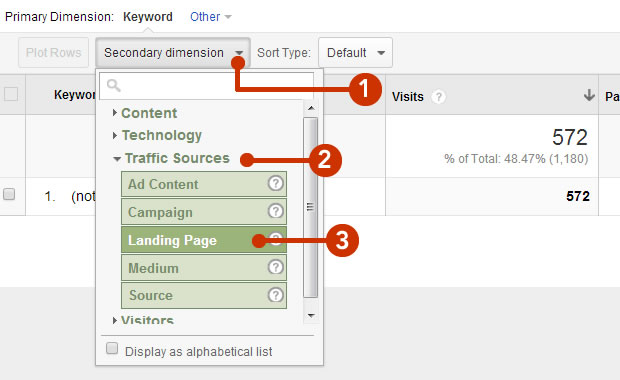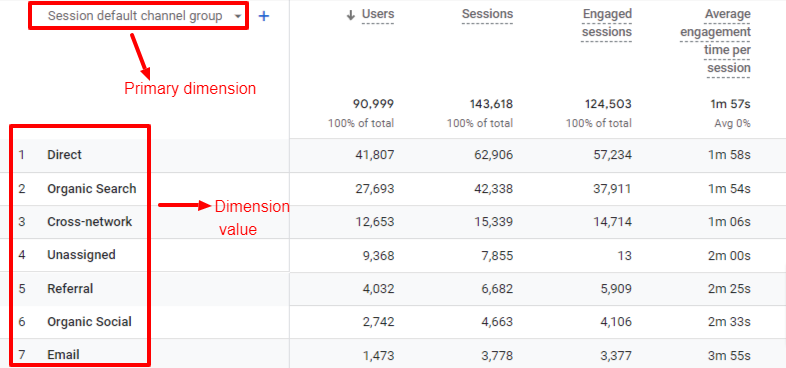Making The Most Of Search Engine Optimization with Secondary Dimension in Google Analytics
Wiki Article
Transform Your Analytics Method With Additional Dimension in Google Analytics
Exploring the capacity of secondary dimensions in Google Analytics opens a realm of possibilities for businesses looking for to raise their logical approach. By integrating secondary dimensions into data evaluation, a new layer of insights arises, dropping light on detailed individual habits and interactions. This sophisticated degree of examination not only improves advertising and marketing techniques however additionally unwinds concealed opportunities for optimization and growth. The critical application of second measurements holds the key to unlocking a bonanza of vital info that can revolutionize just how companies act and interpret upon their information.Recognizing Second Dimensions in Google Analytics
Secondary dimensions in Google Analytics offer extra context to primary information by allowing individuals to assess metrics throughout a 2nd dimension, supplying deeper understandings into customer behavior and interactions on an internet site. Secondary Dimension in Google Analytics. While primary measurements supply basic information factors such as pageviews, bounce price, and session period, second measurements use an even more detailed view by segmenting the key data further. This segmentation enables individuals to analyze metrics in combination with one more dimension, such as traffic sources, demographics, or individual actionsAdvantages of Utilizing Secondary Measurements
Utilizing secondary dimensions in Google Analytics supplies a critical advantage by boosting the depth of evaluation and providing an extra detailed understanding of customer communications and actions on a web site. By incorporating second measurements, experts can gain useful understandings right into the efficiency of certain sectors or variables within their information. This enables a more in-depth exam of customer habits beyond surface-level metrics, permitting a much deeper expedition of the elements influencing user involvement and conversions.
Just How to Implement Additional Measurements
When integrating second dimensions in Google Analytics, one important action is to choose the appropriate metrics and dimensions to enhance the analysis procedure. Clicking on this switch will open up a drop-down food selection listing different measurements that can be added to your key dimension for deeper insights.After picking the ideal second dimension, such as 'Source/Medium' or 'Device Category,' Google Analytics will certainly show the data in a more comprehensive format, permitting you to cross-analyze different elements of customer habits. Bear in mind to trying out different mixes of main and additional measurements to discover beneficial patterns and trends that can inform your marketing techniques. By executing additional dimensions attentively, you can get a much more thorough understanding of your website or app efficiency and make data-driven choices to enhance your digital existence.
Studying Information With Additional Dimensions
Enhance your information analysis in Google Analytics by incorporating additional measurements to delve deeper right into customer habits patterns and maximize your electronic advertising and marketing techniques successfully - Secondary Dimension in Google Analytics. By adding secondary measurements to your key data, you can obtain valuable understandings that can help you make informed decisions concerning your web site or app performance
Examining data with second dimensions permits you to sector your primary data additionally, giving a much more thorough view of individual communications. Combining the informative post primary dimension of 'source/medium' with a second measurement like 'landing web page' can disclose which certain web pages are driving website traffic from various resources. This info can be critical in fine-tuning your material strategy or maximizing your ad campaign to boost conversions.
Additionally, utilizing secondary dimensions allows you to recognize relationships in between various metrics, assisting you comprehend the effect of different variables on user behavior. Whether it's evaluating demographics along with customer involvement metrics or tool classifications with conversion prices, secondary measurements encourage you to uncover concealed fads and patterns that can direct your advertising initiatives.
Maximizing Performance With Second Measurements
To enhance the effectiveness of data analysis and decision-making in Google Analytics, including secondary dimensions is vital to maximizing performance metrics and obtaining much deeper insights right into customer habits patterns. By using second measurements, experts can dig past surface-level information and discover useful relationships that may otherwise go unnoticed. This optimization method makes it possible for services to customize their marketing efforts more successfully, recognize areas for renovation in internet site usability, and improve total individual experience.Additional dimensions use a more thorough view of individual communications by supplying extra context to primary data metrics. Matching the main measurement find out here of 'touchdown page' with an additional dimension like 'tool classification' can expose whether particular devices are a lot more likely to drive involvement on specific touchdown web pages. This understanding can educate responsive layout enhancements or targeted marketing methods to increase efficiency.

Final Thought
To conclude, the integration of secondary dimensions in Google Analytics offers services with a powerful device to enhance their analytics technique. Secondary Dimension in Google Analytics. By diving deeper right into individual behavior and communications, marketing professionals can reveal beneficial understandings that can drive performance optimization and improve the general customer experience. Leveraging additional dimensions enables a more comprehensive analysis of information, bring about even more enlightened decision-making and customized marketing initiativesSecond measurements in Google Analytics supply additional context to main information by allowing users to analyze metrics throughout a 2nd measurement, providing deeper understandings into individual behavior and interactions on an internet site. While key dimensions supply fundamental data factors such as pageviews, bounce price, and session period, secondary dimensions use a more comprehensive view by segmenting the main data additionally.One of the vital advantages of using second measurements is the capability to discover connections and patterns that may not be site web right away evident when analyzing data with key measurements alone.When incorporating secondary measurements in Google Analytics, one important action is to pick the relevant metrics and dimensions to improve the analysis procedure. Coupling the main dimension of 'landing page' with an additional measurement like 'gadget group' can reveal whether specific devices are a lot more most likely to drive engagement on certain touchdown pages.
Report this wiki page